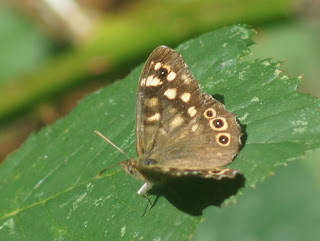The weather was much cooler today, but there were still some sunny spells on my short visit to Cranford Park.
I saw five Red Kites during my visit, including these two soaring the thermals together.....
and six Common Buzzards were seen....
including this very pale one below....
and another one that was right overhead...
I found more fungi in the woods. A new years growth of Turkey Tails was just visible through the undergrowth...
The solitary Stinkhorn didn't look that much different from yesterday, but you could definitely smell it more after last nights rain....
and more Stagshorn had appeared near to the ones I found yesterday...
and you can tell autumn is finally here as the holly berries have started to turn colour.....
In the Headland area you can still hear the occasional cricket or grasshopper. However finding one is quite difficult now the long grass has changed colour and is starting to flatten down.
Spot the Grasshopper below.....
I think it's a Lesser Marsh but identification will be near on impossible without a photo of the whole of the critter.
Right nearby was this tiny bright green gem.....
It's a Short-winged Conehead, a species of bush cricket. It was less than 2cm in length, if you don't include the extra long antennae that are twice as long as the body.
This particular one hasn't yet reached adult form yet......
also lurking in the long dry grasses was this Robber Fly looking for it's next meal......
On the flowering Ivy by the M4 wall I saw another Ivy Bee but couldn't get a photo. There were also three Red Admirals and plenty of hoverflies including this monster Hornet mimic, Volucella zonaria...
Around the orchard the Common Darters were still plentiful but I only found one happy to pose for a photo today....
A very short visit inbetween shopping and other chores, but a nice one all the same, and it was lovely to see my old friends Paul and Sheila too.


























































